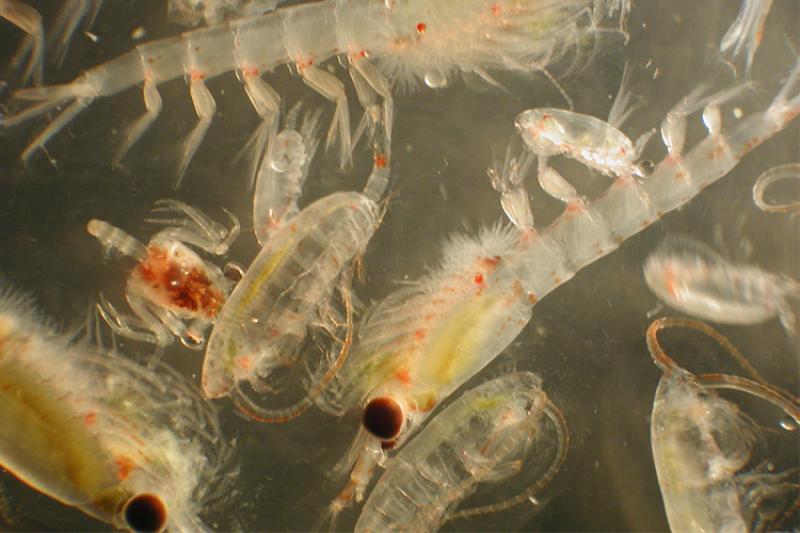From fish to whales, nearly every predator in the sea eats zooplankton, or eats something that does. Understanding how climate impacts zooplankton can help us predict ecosystem changes to build resilient, climate-ready fisheries and communities.
A new collaborative NOAA Fisheries study looked at northern Bering Sea zooplankton over 17 years (2002–2018) of both cold conditions and unprecedented heat. The research revealed that loss of sea ice resulted in dramatic shifts. Large, high-fat copepods that are important food for many predators dwindled, while small zooplankton expanded in both number and range. This altered prey field may have contributed to ecosystem-wide impacts on fish, seabirds, and marine mammals.
“Zooplankton are near the base of the marine food web. If the base changes, we will see changes higher in the foodweb. There will be species that respond better than others,” said study lead Dave Kimmel, NOAA Fisheries, Alaska Fisheries Science Center EcoFOCI program. “By studying zooplankton we can see what the future ecosystem might look like. That knowledge can help people who make a living on it, or manage it, adapt and prepare.”
Rapid Change in the Wake of Retreating Sea Ice
Over recent decades, many climate-driven ecosystem changes have been documented in the southeastern Bering Sea. But less is known—or expected—for the north.
“Historically it was thought that reliable ice cover and the cold pool would insulate the northern Bering Sea from climate change for the next 50 years,” Kimmel said. “But now we’ve seen years when sea ice and the cold pool virtually disappeared due to an extreme event. This ecosystem is changing much more rapidly than expected.”
Dramatic ecosystem-wide effects followed unprecedented loss of sea ice in 2017–2018 and a 2019 heatwave:
- Northward movement of fish populations
- Shifts in forage fish distributions
- Sea bird die-offs
- Declining body condition of seals
- Dramatic declines in Alaska crab stocks
- Unusual mortality event for bearded, ringed, and spotted seals.
Collaboration Unlocks Wealth of Information From Long Survey Time Series
To understand how climate drove these changes, and predict how the ecosystem may respond to continued warming, scientists needed to know what happened to zooplankton.
“We took advantage of zooplankton data from a 17-year survey time series that our collaborators at Auke Bay Laboratories had collected as part of a salmon fisheries oceanography survey with Alaska Department of Fish and Game,” Kimmel said. “Working collaboratively with them and our partners at University of Alaska, we were able to extract a wealth of information from data that had already been collected.”
Long-term studies such as those conducted by NOAA’s EcoFOCI program are our best available tool for predicting climate-driven ecosystem change. By looking at how the ecosystem responded to past climate variability, we can better predict how it will respond to future climate change.
Smaller Species, Disappearing Boundaries, and a Strange Bloom
In addition to the major shift from large to small copepods, the team saw other changes in zooplankton with warming.
“We were surprised at the degree to which nearshore zooplankton spread and grew with warming,” Kimmel said. “There are usually distinct nearshore and offshore zooplankton communities. With the disappearance of ice and the cold pool, that separation seemed to have broken down. ”
Another surprise was the explosion of a typically uncommon small copepod.
“We saw very high abundances of Epilapidocera. It is an interesting copepod as it has blue pigmentation. Little is known about its ecology,” said Kimmel, “or what caused their numbers to increase so dramatically.”
Meroplankton—animals that are planktonic for part of their life before settling to the bottom—flourished and expanded offshore from nearshore waters. This contributed to the surge in small zooplankton.
Cascading Impacts Throughout the Ecosystem
The shift to smaller, more nearshore zooplankton may have contributed to dramatic impacts on commercially harvested fish, protected seabirds, and marine mammals in recent years.
Previous studies have shown that a smaller zooplankton prey field means less energy reaches predators higher in the food web. Smaller zooplankton tend to be less nutritious, both in terms of total energy and fat content. Also there are likely more food chain links between small prey and higher predators—and energy is lost on each link.
Frontline of Climate Change
The study findings will inform sustainable ecosystem-based fisheries management of Alaska’s valuable marine resources in the face of climate change.
“The northern Bering Sea is on the front line of climate change. In the study of ecosystems you rarely see large-scale changes this rapid and dramatic,” Kimmel said. “We need to increase our monitoring to be able to predict change so people won’t be completely surprised by an ecosystem that is not going to behave as it has in the past.”
This research was a collaborative effort between NOAA Fisheries Alaska Fisheries Science Center (Dave Kimmel, Lisa Eisner) and the University of Alaska Fairbanks (Alexei Pinchuk).











